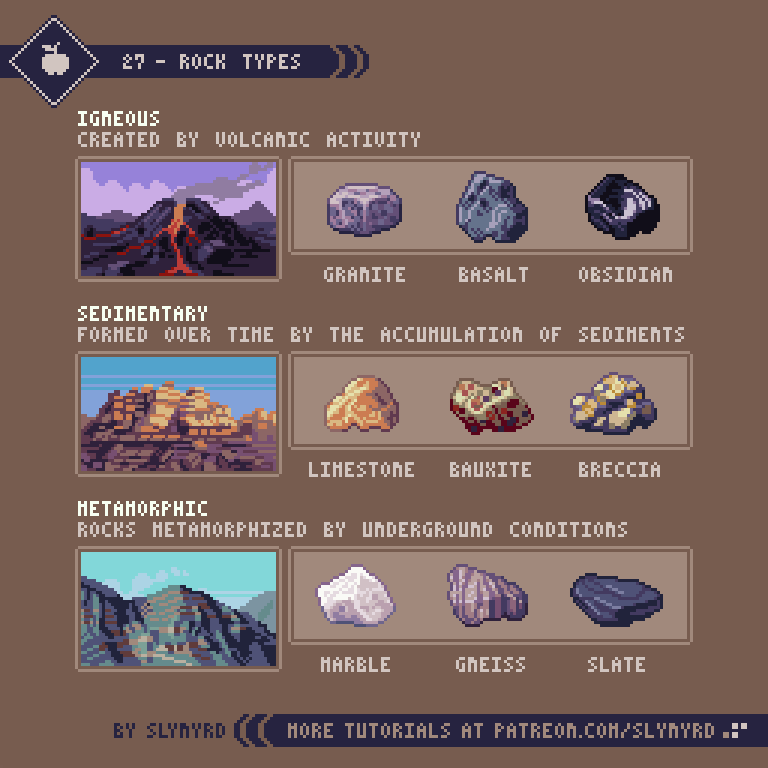Intro
They make up the mountains, they are in the ground under your feet, the wonderful world of rock is all around us. As an artist, it’s important to be able to depict this abundant material in its many forms. Thankfully, the pixel is a finely suited for the task. There’s something incredibly satisfying about well rendered pixel art rocks that just can’t be captured in other mediums.
The 3 types of rocks
First, let’s review some elementary rock knowledge. Rock is a hard natural material forming the surface of the Earth and other similar planets. This hard material is made out of many different minerals and mineral like materials. A wide variety of colors and texture can be discovered in the world of rocks, however, they can all be narrowed down to 3 main types based on how they are formed.
Understanding how rocks are formed and familiarizing with specific examples can help you design environments with more accuracy. Such thoughtful design enhances world building and immersion. Besides, what’s more inspiring than the real science happening around us?
Simple ROCK
While realism is appreciated, the limits of pixel art can make it difficult to capture the fine textural details of what makes up rock. Usually, generic gray rock gets the job done. If I had to get technical, I suppose this would be some kind of granite, phyllite, slate? What’s most important is the color and shape fits the geology of the environment. For example, in a canyon made of reddish oxidized rock, a gray stone would look out of place. In that case, a simple palette swap might do the trick, but it’s also important the shape makes sense. Every rock tells a story.
I tend to use this outline approach when creating larger stone sprites, as the angular lines lead to a sharp, hard look. However, I sometimes use a blocking approach and start with solid blobs of color, then chisel down the form as I go. Especially if the sprite is very small, I won’t bother with the outline steps.
Mountains
Basically, really big pointy rocks. Mountains are some of the most majestic features of the planet. Growing up in a flat region, I’m always awestruck by any formation taller than my house.
Before you start slapping down color, it’s always good to study references, especially in concerns to natural scenery. I suggest studying many references to become familiar with common shapes and shadows seen in mountains. With practice, you will eventually be able to conjure up mountains with little to no reference.
Final Thoughts
On paper, the sound of a rock tutorial seemed a bit mundane to me, but I really got into it. I had forgotten the basics of the rock cycle, and just how fascinating these materials right under our feet truly are. Of course, we all can appreciate the beauty of a mountain range, but when is the last time you picked a stone off the ground, marveled at the texture, and contemplated its origins? With kid like curiosity, I find myself captivated by the geologic world and hope to make more rock themed tutorials in the future. Rare minerals and precious gems would surely be fun to pixel.
RESOURCES
Was this article helpful? If you find value in my content please consider becoming a Patreon member. Among many other rewards, Pixel Insider members get extra resources to compliment my tutorials. But most importantly, you allow me to continue making new content.
Assets featured in this Pixelblog are available in Rocks Assets Pack
All graphics in this tutorial use my custom palette Bright Future
Get caught up on all my downloads
If you're not ready to commit to the subscription model of Patreon, make a one-time donation and receive exclusive art and resources. Fan support is necessary to keep producing content. Thank you!
-By Raymond Schlitter



